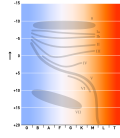units, luminosity is measured in joules per second, or watts. In astronomy, values for luminosity are often given in the terms of the luminosity of the...
24 KB (3,002 words) - 09:29, 25 September 2024
In astronomy, a luminosity function gives the number of stars or galaxies per luminosity interval. Luminosity functions are used to study the properties...
7 KB (957 words) - 18:57, 1 March 2024
solar luminosity (L☉) is a unit of radiant flux (power emitted in the form of photons) conventionally used by astronomers to measure the luminosity of stars...
6 KB (611 words) - 18:09, 19 February 2024
The Eddington luminosity, also referred to as the Eddington limit, is the maximum luminosity a body (such as a star) can achieve when there is balance...
30 KB (3,261 words) - 01:16, 30 December 2024
In astronomy, a period-luminosity relation is a relationship linking the luminosity of pulsating variable stars with their pulsation period. The best-known...
20 KB (2,319 words) - 20:14, 10 December 2024
Star (redirect from Star (astronomy))
as will the star's temperature and luminosity. The Sun, for example, is estimated to have increased in luminosity by about 40% since it reached the main...
148 KB (16,436 words) - 06:00, 6 January 2025
yacht Luminosity — Ignite the Night!, a former Cedar Point amusement park show that was shown from 2012 to 2017. Luminosity function (astronomy), a function...
1 KB (229 words) - 17:11, 7 February 2022
steadily increased in luminosity by 40% since it first became a main-sequence star. The Sun has also undergone periodic changes in luminosity that can have a...
102 KB (10,439 words) - 20:57, 8 December 2024
classification Luminosity comparison: LS, L☉ - luminosity of the Sun Luminosity of certain object: Lacc - accretion luminosity Lbol - bolometric luminosity Mass...
5 KB (505 words) - 13:51, 28 October 2024
In astrophysics, the mass–luminosity relation is an equation giving the relationship between a star's mass and its luminosity, first noted by Jakob Karl...
16 KB (2,672 words) - 02:49, 21 November 2024
Hertzsprung–Russell diagram (redirect from Color-luminosity diagram)
same spectral classification. He took this as an indication of greater luminosity for the narrow-line stars, and computed secular parallaxes for several...
23 KB (2,771 words) - 01:42, 18 July 2024
higher than normal luminosity over some part of the electromagnetic spectrum with characteristics indicating that the luminosity is not produced by stars...
165 KB (19,036 words) - 10:30, 15 January 2025
Stellar classification (redirect from Luminosity class)
older Harvard spectral classification, which did not include luminosity) and a luminosity class using Roman numerals as explained below, forming the star's...
106 KB (11,560 words) - 11:18, 4 January 2025
Supergiant (section Spectral luminosity class)
the definition of spectral luminosity classes, with class I referring to supergiant stars. The same system of MK luminosity classes is still used today...
39 KB (5,371 words) - 18:49, 20 July 2024
Cosmic distance ladder (redirect from Distance (astronomy))
Planetary nebula luminosity function (PNLF) Globular cluster luminosity function (GCLF) Surface brightness fluctuation (SBF) In galactic astronomy, X-ray bursts...
54 KB (7,874 words) - 13:31, 20 October 2024
Stephenson 2 DFK 1 (section Luminosity)
giving a relatively modest luminosity of 90,000 L☉. Two years later, a new calculation for finding the bolometric luminosity by fitting the Spectral Energy...
21 KB (2,382 words) - 09:44, 13 January 2025
(November 1997). "Luminosity and related parameters of δ Scuti stars from HIPPARCOS parallaxes. General properties of luminosity". Astronomy and Astrophysics...
12 KB (1,059 words) - 17:18, 18 August 2024
intrinsic luminosity, its distance, and the extinction reducing its brightness. The absolute magnitude (M) describes the intrinsic luminosity emitted by...
26 KB (2,920 words) - 02:31, 14 October 2024
Absolute magnitude (redirect from Absolute luminosity)
In astronomy, absolute magnitude (M) is a measure of the luminosity of a celestial object on an inverse logarithmic astronomical magnitude scale; the more...
50 KB (5,774 words) - 04:40, 20 January 2025
working assumptions in stellar astronomy. The Italian astronomer Geminiano Montanari recorded observing variations in luminosity of the star Algol in 1667...
84 KB (10,313 words) - 17:07, 14 January 2025
Sun (redirect from Sun (astronomy))
remains, contributing to the increased luminosity, which will eventually reach more than 1,000 times its present luminosity. When the Sun enters its red-giant...
165 KB (18,176 words) - 16:11, 19 January 2025
Main sequence (category Concepts in astronomy)
times the solar luminosity. At metallicity Z = 0.01 the luminosity is 1.34 times solar luminosity. At metallicity Z = 0.04 the luminosity is 0.89 times...
61 KB (6,826 words) - 13:22, 14 January 2025
List of most luminous stars (category Lists of superlatives in astronomy)
bolometric luminosity in multiples of the luminosity of the Sun (L☉) and the bolometric absolute magnitude. As with all magnitude systems in astronomy, the...
171 KB (10,597 words) - 16:28, 21 December 2024
Surface brightness (category Observational astronomy)
depends on its surface luminosity density, i.e., its luminosity emitted per unit surface area. In visible and infrared astronomy, surface brightness is...
9 KB (1,079 words) - 17:33, 23 August 2024
star sensor. The X-ray luminosity of Lx = 1031 erg·s−1 (1024 W) is four orders of magnitude above the Sun's X-ray luminosity. Coronal stars, or stars...
65 KB (8,115 words) - 13:32, 13 April 2024
Canopus (redirect from Canopus (astronomy))
essentially white when seen with the naked eye. It has a luminosity over 10,000 times the luminosity of the Sun, is eight times as massive, and has expanded...
62 KB (7,306 words) - 12:05, 12 January 2025
VY Canis Majoris (section Luminosity)
of the luminosity based on an assumed distance of 1.5 kpc (4,900 ly) gave luminosities between 200,000 and 560,000 times the Sun's luminosity (L☉). This...
63 KB (6,874 words) - 00:21, 20 January 2025
Astronomical transit (redirect from First contact (astronomy))
star there is a dimming in the luminosity of the host star that can be measured. Larger planets make the dip in luminosity more noticeable and easier to...
17 KB (1,927 words) - 12:22, 17 October 2024
objects are present in given part of the sky, there always is some low luminosity present, due mostly to light diffusion from the atmosphere (diffusion...
3 KB (482 words) - 15:29, 20 November 2024
and luminosity to the secondary member. As a result, the components in a contact binary often have similar effective temperatures and luminosities, regardless...
5 KB (511 words) - 17:18, 24 November 2024

















